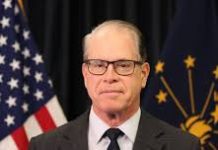Some Indiana Schools WIll Reopen Without A Full-Time Nurse, Raising Concerns
In an ideal world, Perry Central Community Schools would reopen in August with two full-time nurses to oversee the health of its 1,250 students. Instead, the rural district will have just one full-time nurse in charge of the K-12 building’s two clinics: one for regular nursing and one for potential COVID-19 cases.
That nurse will also help the small, rural district create and maintain its symptom screening policy and work with the local health department to decide when to ramp up cleaning and personal protection efforts said, Superintendent Tara Bishop.
Before the pandemic closed buildings, not every school in Indiana had a dedicated, full-time nurse, according to officials. The state only requires that each district have at least one, even if it includes multiple buildings. And advocates say many districts don’t meet the nationally recommended ratio of one nurse for every 750 students.
Now, the importance of having a medical profession is heightened as districts work through how to reopen safely during the ongoing pandemic.
“I think it’s critical to have a school nurse on site,†Bishop said. “The need is even more amplified right now because of COVID-19. As an educator, I’m not a healthcare professional. Having someone who is is more important now than I think it’s ever been.â€
A group of Indianapolis parents recently put together a list of conditions they’d like to see schools meet before they send their children back, including a call for every school to have its own nurse. State Superintendent Jennifer McCormick previously acknowledged the importance of school nurses amid the pandemic, but so far there don’t appear to be state-level conversations about assisting schools in hiring more medical professionals.
“Of course I would love to see a school nurse in every building,†said Andrea Tanner, President of the Indiana Association of School Nurses. “But I also know in the same breath everything I hear is that there is going to be less and less funding and oftentimes positions like school nursing are the first cut. I think school districts are in a really, really tough position to try to do more and more with less and less.â€
In lieu of a second full-time nurse, Perry Central has part-time help from a person with a medical background. The health teacher, who is also a nurse, will help monitor the COVID-19 health center. The district can’t afford to hire another full-time medical professional, Bishop said, and it received little federal coronavirus aid, which was doled out based on the poverty level of its students.
It’s difficult to get a sense of exactly how many of Indiana’s thousands of schools are without a nurse because the state only tracks the number of certified nurses employed by the district.
State data shows more than 400 districts and charter schools reported employing 1,165 nurses last school year. But that number doesn’t provide a complete picture of the medical professionals working in schools. State data doesn’t always include schools that contract with hospitals or health networks to hire and train their nurses.
Indianapolis Public Schools, for example, reports 16 school nurses. In reality, the district employs nine nurses and provides 27 additional health professionals through five contractors, including the Marion County Health Department.
Last year, 36 IPS schools had a full-time nurse, said Cortnei Flucas, interim IPS unified student supports officer, and the district plans to maintain that staffing level when it reopens. Other nurses split their time between two buildings, like at Shortridge High School and IPS/Butler Lab School 60.
For those schools, Flucas said the district will identify a staff member to “initiate the established safety protocols and have access to an IPS nurse for consultation and intervention on a case by case basis.â€
When IPS’ Wendell Phillips School 63 restarted as a charter school two years ago, becoming Matchbook Learning, school leaders said the first thing they did was bring in a full-time nurse, despite only having around 420 students at the time. The school contracts with Shalom Health Care Center, which provides a nurse practitioner — a higher qualification that allows them to diagnose students and write prescriptions.
Having a nurse practitioner makes a big difference for families who work hourly jobs, who may not have health insurance, or who struggle to take time off and get their child to a doctor when they are sick, said CEO Amy Swann.
School nurses are a key piece of the schools’ COVID-19 response team, Swann said, helping craft the policy for screening for coronavirus symptoms and working as a liaison with the local health department. They’ll also keep an eye on students who are at a higher risk for contracting COVID-19.
Nurses will be help monitor for symptoms and immediately quarantine students in designated areas or help them seek further medical attention. They can also help with contact tracing should a student or staff member test positive, and launch an appropriate emergency response, which could include additional cleaning or screening other people who were in their classes. And they can serve as a point of contact for parents.
“We’re not the experts,†Swann said. “That school nurse is really going to be taking the lead there, making sure that the policies, procedures, and practices in place are best for keeping our kids and staff healthy.â€




